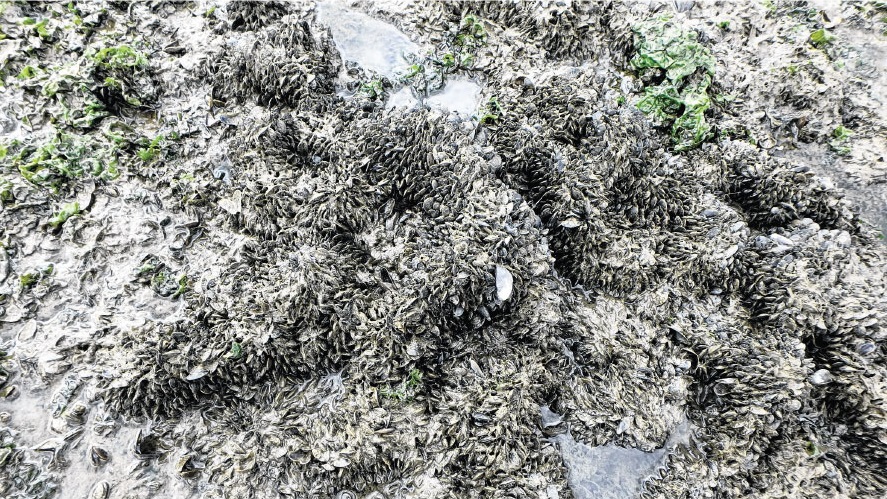Mussel calamity: Shellfish from the Americas carpeting Singapore shores, could muscle out local species
Sign up now: Get ST's newsletters delivered to your inbox

Invasive American brackish-water mussels have been encrusting Kranji mudflats.
PHOTO: RIA TAN/WILDSINGAPORE.COM
Follow topic:
SINGAPORE - A mussel calamity has befallen the Republic's northern shores.
Since 2016, a new species of mussel that could have come from as far away as the Americas has been spreading rapidly along Singapore's northern coast, clogging up nets in fish farms and displacing the Asian green mussel native to Singapore, as they compete with the local molluscs for space.
Observed in clumps of up to 10,000 individual shellfish, the invasive American brackish-water mussel has also been forming dense mats in the Kranji mudflats - home to rare horseshoe crabs - to the dismay of nature groups here.
Studies on the impact that the invasive mussels have on local ecology, including how it will affect the ancient horseshoe crabs, are ongoing. But there is concern the appearance of the mussels in the horseshoe crabs' habitat in such dense numbers has made it difficult for the latter to burrow into the sand where the creatures lay their eggs.
This is the first time the mussel Mytella strigata has been recorded in Singapore waters, said National University of Singapore (NUS) scientists studying the phenomenon during a media briefing on Friday (March 2).
The research was led by Dr Serena Teo and Dr Tan Koh Siang, both senior research fellows at the Tropical Marine Science Institute under NUS.
According to the research paper by the six NUS scientists, the mollusc could have come from Brazil, Colombia or Ecuador - countries where these animals are naturally found - or from the Philippines, where they have been introduced since the 19th century.
Larvae from the mussel, which can grow up to 5cm in length, could have been transported to Singapore by ballast water in ships, usually taken on board to provide stability, noted the study, which was published last month in the science journal Molluscan Research.

According to the United States' National Oceanic and Atmospheric Administration (NOAA), invasive species are animals or plants from another region of the world that do not belong in their new environment.
"They can be introduced to an area by ship ballast water, accidental release, and most often, by people. Invasive species can lead to the extinction of native plants and animals, destroy biodiversity, and permanently alter habitats," said the NOAA on its website.
Invasive species such as the American mussel could hurt also Singapore's status as a top transhipment hub globally. The Republic, like many coastal cities with urban harbours, is vulnerable to invasions by such shellfish.
When invasive mussels attach to hard surfaces, they form clumps in places such as on seawater intake pipes and vessels. Such undesirable marine growth on man-made surfaces is known as biofouling.
These clumps can reduce vessel speeds by more than 10 per cent due to drag, and increase fuel consumption of ships when they power up to overcome it. Such marine pests can also damage engines and propellers.
Findings from the NUS researchers' study suggest that the foreign mussels could muscle out their native counterparts in fish farms here.
The researchers placed nylon sheet netting underwater at a floating fish farm off Changi. The netting was first put out in September 2014 and renewed every month between October 2014 and February last year.
Before February 2016, the only mussel species found on the netting was the native Asian green mussel. But since March 2016, the invasive Mytella strigata was observed in rising numbers, and the number of Asian green mussels decreased.
The National Parks Board (NParks), custodian of Singapore's nature areas, told The Straits Times that it was first made aware of the mussels early last year, and that it is currently collaborating with experts from NUS on research to better understand the mollusc.
Dr Karenne Tun, director of the marine division at NParks' National Biodiversity Centre, said the board will be working with experts from NUS to assess the presence and potential movement of the mussels within Singapore's waters using eDNA techniques.
"This would enable us to develop a holistic science-based management plan for the species. At the same time, NParks and the Tropical Marine Science Institute will be working with volunteers from the Marine Conservation Group of the Nature Society (Singapore) on a mussel removal programme at areas most impacted by the mussels," said Dr Tun.
Mr Stephen Beng, chair of the Nature Society's marine conservation group, said the invasive mussels have "devastated" the Kranji mudflats, an ecologically important habitat.
"We've noted their encroachment since end of 2015 but only received confirmation that it was an invasive species much later," he told ST.
He said parties involved need to strengthen collaborative efforts and tighten communication loops in dealing with apparent threats.
"For now, the horseshoe crab rescue and research volunteers are willing to clear the mussels even if it's a short term strategy but we want to focus on ecological studies to understand how the species lives and interacts. This will help us develop interventions that may help to manage the spread and hopefully eradicate the problem.
"We've noted their encroachment since end of 2015 but only received confirmation that it was an invasive species much later," he told ST.
He said parties involved need to strengthen collaborative efforts and tighten communication loops in dealing with apparent threats.
"For now, the horseshoe crab rescue and research volunteers are willing to clear the mussels even if it's a short term strategy but we want to focus on ecological studies to understand how the species lives and interacts. This will help us develop interventions that may help to manage the spread and hopefully eradicate the problem.

